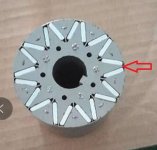liveforphysics said:
That's how you win at power factor on your drives output, but you win reluctance torque by leading it with current out of BEMF phase sync. However, aside from EMC harmonic generation, I don't think the hotrod EV user cares about power factor.
You're correct that power factor is maximized when the current vector is perfectly aligned with the voltage vector.
There are really two EMFs in a salient motor with permanent magnets (IPM)
The magnets in an IPM produce an EMF which is aligned with the q axis. This is traditional BEMF.
If there is current on the d axis, it will create an EMF on the q axis of w*Ld*Id, and likewise current on the q axis will create an EMF on the d axis of w*Lq*Iq. Let's call this reluctance-EMF (REMF, not a technical term)
In an SPM with no saliency, there is a large BEMF which is aligned with the q axis, and relatively small REMF which is perpendicular to the present current vector. We can get torque by aligning the current vector with the BEMF, but it is impossible to get torque from the REMF because it is inherently perpendicular to the current vector. In an SPM, the REMF only serves to reduce power factor and therefore the speed range of the motor.
In an IPM, there is still a BEMF which we can align to, but in this case Ld and Lq are different, so the REMF is not in general perpendicular to the current vector, and thus we can derive torque from this. This is reluctance torque.
Not only that, but the fact that this vector has a parallel component means it can be used to very effectively oppose the BEMF, leading to these motors' large field weakening potential and decent power factor.
In a traditional motor control system, we have an absolute encoder attached to the motor. To take advantage of the REMF (reluctance torque) we need to offset our current vector from the q axis, and normally a table is used for this.
If, theoretically, you had a perfect observer of the back EMF - it would not only be sensitive to the BEMF but also the REMF. This means the q axis observed by the observer would not be the physical q axis of the system, but would rather be aligned with this EMF. This should allow the system to naturally follow the MTPA trajectory, because it is
not tracking the physical q axis of the rotor.
Of course, this doesn't work at standstill because there is no EMF to track. You will certainly need a table to maximize torque at standstill.
I don't know the details of how (or if) this works in Lebowski's controller, but that's the theory of why aligning to EMF produces max torque, even in an IPM. The reason this is not widespread is because developing observers which are stable, accurate, and robust to changes in speed, inductance, temperature, resistance, load, saturation, current, etc. is extremely difficult.



